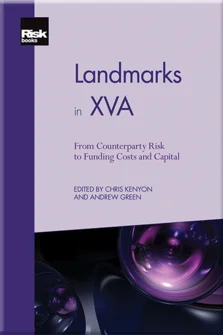The FVA Debate
John C Hull and Alan D White
The FVA Debate
Introduction
Preface to Chapter 1
Being Two-Faced over Counterparty Credit Risk
Risky Funding: A Unified Framework for Counterparty and Liquidity Charges
DVA for Assets
Pricing CDSs’ Capital Relief
The FVA Debate
The FVA Debate: Reloaded
Regulatory Costs Break Risk Neutrality
Risk Neutrality Stays
Regulatory Costs Remain
Funding beyond Discounting: Collateral Agreements and Derivatives Pricing
Cooking with Collateral
Options for Collateral Options
Partial Differential Equation Representations of Derivatives with Bilateral Counterparty Risk and Funding Costs
In the Balance
Funding Strategies, Funding Costs
The Funding Invariance Principle
Regulatory-Optimal Funding
Close-Out Convention Tensions
Funding, Collateral and Hedging: Arbitrage-Free Pricing with Credit, Collateral and Funding Costs
Bilateral Counterparty Risk with Application to Credit Default Swaps
KVA: Capital Valuation Adjustment by Replication
From FVA to KVA: Including Cost of Capital in Derivatives Pricing
Warehousing Credit Risk: Pricing, Capital and Tax
MVA by Replication and Regression
Smoking Adjoints: Fast Evaluation of Monte Carlo Greeks
Adjoint Greeks Made Easy
Bounding Wrong-Way Risk in Measuring Counterparty Risk
Wrong-Way Risk the Right Way: Accounting for Joint Defaults in CVA
Backward Induction for Future Values
A Non-Linear PDE for XVA by Forward Monte Carlo
Efficient XVA Management: Pricing, Hedging and Allocation
Accounting for KVA under IFRS 13
FVA Accounting, Risk Management and Collateral Trading
Derivatives Funding, Netting and Accounting
Managing XVA in the Ring-Fenced Bank
XVA: A Banking Supervisory Perspective
An Annotated Bibliography of XVA
When valuing European options in the early 1970s, Fischer Black, Myron Scholes and Robert Merton (BSM) showed that, over any short period of time, an investment in an option could be replicated with a portfolio of stock and risk-free debt. This observation allowed them to calculate the economic value of the option by solving a differential equation. Subsequent analysis showed the economic value of the option could also be determined by discounting the expected payoff on the option in a risk-neutral world at the risk-free rate of interest. The calculated value is “economic” in the sense that, if the option price were different from this value, an investment in the option would dominate an investment of equivalent risk in a portfolio of debt and equity. The BSM analysis also showed that if it were possible to borrow and lend at the risk-free rate of interest, the replicating portfolio could be used as a hedge for the option.
Prior to the credit crisis that started in 2007, the London Interbank Offered Rate (Libor) was thought to be the best proxy for the risk-free rate, and it was assumed banks could borrow and lend at that rate, allowing them to carry out the replicating trading
Copyright Infopro Digital Limited. All rights reserved.
As outlined in our terms and conditions, https://www.infopro-digital.com/terms-and-conditions/subscriptions/ (point 2.4), printing is limited to a single copy.
If you would like to purchase additional rights please email info@risk.net
Copyright Infopro Digital Limited. All rights reserved.
You may share this content using our article tools. As outlined in our terms and conditions, https://www.infopro-digital.com/terms-and-conditions/subscriptions/ (clause 2.4), an Authorised User may only make one copy of the materials for their own personal use. You must also comply with the restrictions in clause 2.5.
If you would like to purchase additional rights please email info@risk.net











